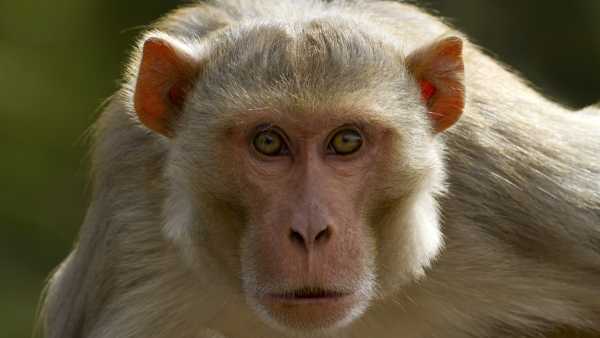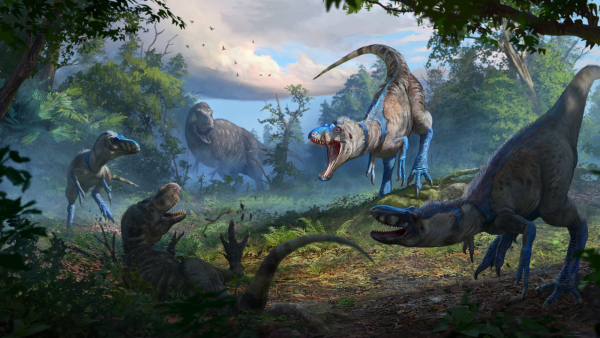
It's time to talk about the most prominent representatives of this tribe. In doing so, I'll touch not only on zoology, but also on literature, religion, and even philosophy.
Turtles big, small and bizarre
Let's start with true turtles. The largest of them are marine turtles, which is unsurprising—life is always easier for giants in the water. Among modern turtles, the leatherback turtle holds the record, with a shell reaching two meters in length and weighing 600 kg. Even more impressive is its wingspan… sorry, flippers—about 3 meters!
But these achievements pale in comparison to the extinct Archelon turtle, with a nearly 5-meter-long shell and a weight of 5 tons. It, too, had its enemies—after all, this turtle lived in the seas of the Cretaceous period of the Mesozoic era, where the rather formidable serpentine marine lizards known as mosasaurs preyed.
Land tortoises are more modest in size, though they look even more impressive than marine ones. Consider, for example, the Galapagos tortoise with its 110-centimeter shell and enormous columnar legs, or the Aldabad giant tortoise (shell – 123 cm).
But even here, extinct species lie ahead. The largest land tortoise today is the Meiolania. Its shell alone was 2.5 meters long, and with its impressive head and tail, its length reached 5 meters. Interestingly, the Meiolania became extinct not so long ago—2,000 years ago.
Among freshwater turtles, the alligator snapping turtle, native to North American waters, is the leader. However, it's not only its five-foot-and-a-half-inch size that makes it stand out, but also its menacing appearance. The alligator snapping turtle, like its compatriot, the snapping turtle, is quite aggressive and dangerous to those who disturb it. Despite its toothless beak, it can use it just as well as a human can use wire cutters. However, the alligator snapping turtle doesn't feed on human fingers, but on fish, and it catches them in a rather amusing way. The turtle's tongue is remarkably reminiscent of a pink worm. So the alligator snapping turtle lies there, its mouth open, like its own fishing rod, waiting for a fish to bite its bait.
The South American matamata also has its own underwater hunting methods—perhaps one of the most bizarre and comical turtles. It has a long neck, elongated nostrils (for easier breathing underwater), and a wide, “smiling” mouth. Its head is covered in numerous protrusions that not only provide excellent camouflage but also attract naive fish.
A. Carr “Reptiles”:
“In Colombia, where it's very common along the swampy riverbanks, women of one Indian tribe are said to resemble the matamata. I still hope they don't say this to their faces!”
The long-necked turtle has an even more impressive “fishing rod.” Its shell is small—just 26 cm—but its neck is almost as long!
As for the smallest, the record belongs to the South African speckled tortoise, whose shell is only 11 cm. It's not a tortoise, but a real turtle!
The Turtle at the Foundation of the World
The tortoise shell so fascinated ancient people with its strength and beauty that they often used it as the foundation of the entire world. Thus, the Indians “loaded” the world tortoise with four elephants, and placed the earth (flat, of course) on top.
The Iroquois and Hurons also believe that the land was formed when Muskrat (or Frog) placed on the back of a turtle a portion of the earth scooped up from the bottom of the Primordial Ocean.
There's also a well-known Indian myth about the so-called “churning of the ocean.” It tells how the gods and Asura demons decided to extract the drink of immortality—amrita—from the waters of the world's oceans. To do this, they built a giant mixer. An inverted Mount Meru served as the churning rod, a giant serpent served as the churning rod, and the stopper was a turtle, transformed into the god Vishnu himself.
The Chinese were not far behind the Indians. It is said that soldiers of the Chinese Imperial Army carried a flag depicting a turtle and a dragon, symbolizing invulnerability (the turtle cannot reach the dragon, and the dragon cannot eat it).
A cross between a tortoise and a dragon called the bixi is also very popular in China. Bixi is often used in Chinese architecture as a support, supporting pillars of imperial tombs and steles with inscriptions.
The tortoise shell served not only as a symbol of strength but also as a source of wisdom. Yu the Great, the legendary founder of China's first Xia Dynasty, saw on a tortoise shell complete information on China's topography and geographical nomenclature, as well as the lo shu magic square. Therefore, when the emperor had to save China from a flood, he called upon the same dragon and tortoise for help. The dragon dug canals ahead, and the Black Tortoise swam behind Yu's boat, carrying on its back “sazhan”—the substance with which the emperor created the necessary mountains and hills.
The Chinese also used turtle shells for fortune telling – they would cauterize cracks in them and try to discern signs of fate in the resulting pattern.
“Shu Jing” (the canon of scriptures):
“When in doubt about any important matter, ask your heart; ask your courtiers; ask the people; ask the yarrow and the tortoiseshell.”
It was on a tortoise shell that another legendary emperor, Fuxi, saw the basic trigrams (a combination of solid and broken lines). These trigrams became the basis of the famous I Ching, the Book of Changes, which is still used for fortune telling today.
Few people today believe in a turtle bringing peace. Nevertheless, it found a home in Terry Pratchett's wonderful satirical fantasy series about the Discworld. This world, as expected, rests on the proverbial elephants and a turtle named Great A'Tuin, who floats through space from who knows where to who knows where. Discworld telepathic scientists even tried to read A'Tuin's mind to understand the nature of the universe, but to no avail. However, they did manage to read the elephants' thoughts: they were very bored and their backs hurt terribly…
However, turtles did indeed go to space.
On September 21, 1968, the Soviet spacecraft Zond-5 landed (or rather, splashed down) in the Indian Ocean. When sailors from the Soviet ship attempted to raise Zond-5 onto the deck, they heard a strange noise and thumping sounds. Fearing that the craft might be equipped with a self-destruct device, they immediately contacted scientists at the space center. It turned out that the noise was coming from two Central Asian tortoises, which had been launched into space along with fruit flies and mealybugs. As a result, these hardy creatures became the first living creatures to orbit the Moon.
And in 1975, the tortoise-cosmonauts set a second animal record by staying aboard the Soyuz-20 spacecraft for 90 days.
Zeno's paradoxical tortoise
There lived a Greek philosopher named Zeno. He was a student of another philosopher, Parmenides, who claimed that the world is full (i.e., has no void), one in everything, homogeneous, and motionless. And all that movement, space, and time are simply illusions.
Since not everyone shared such a bold theory, Zeno decided to demonstrate the absence of motion by posing a series of paradoxical aporias. We are, of course, interested in the aporia of Achilles and the tortoise.
Imagine, Zeno said, that Achilles decided to race a tortoise. Naturally, the mighty hero gives the reptile a head start, and when the tortoise has retreated a certain distance, he begins to run. And then something strange happens. By the time Achilles reaches the point where his rival was, time has passed, during which time the tortoise has retreated some more. By the time the runner reaches the next point, the tortoise has retreated again. And although the distance between them will shrink, it will shrink infinitely, and therefore Achilles will never catch the tortoise.
Paul Valéry “Cemetery by the Sea”: Zeno of Elea, striking with his thoughts,
Pierced me through with a trembling arrow,
Although he himself neglected her flight.
I was born by sound, struck by an arrow.
Will the shadow of a turtle really cover me?
The swift run of motionless Achilles!
From a common-sense perspective, there's nothing to talk about here. So the famous Diogenes, tired of arguing with the Parmenides and Zeno enthusiasts, lost his temper and simply started pacing back and forth, proving that there was movement. “Hey! Who knows what we see,” the Zenonians and Parmenides responded. “But logic is a precise instrument.”
The catch, as often happens, lay in the very language of the problem, which used terms like “point” and “moment in time”—that is, abstract concepts that don't exist in reality. As a result, the movement turned from a continuous process into a discontinuous, discrete one. Simply put, Achilles would easily traverse all these countless “points” in a finite amount of time because they aren't spatial units.
Evgeny Lukin:
And where did you go?
Achilles?
He said: “That thing over there?
I'll catch up!
To no one, damn it,
can't catch
philosophical turtles
in skulls.
Zeno's efforts were not in vain, however, forcing his Pythagorean opponents to consider whether it was really correct to represent time and space as a set of discrete units.
Bertrand Russell:
“Zeno's arguments have, in one form or another, served as the basis for almost all the theories of space, time, and infinity put forward after him.”
The turtle is both a victim and a killer.
For a long time, people believed that of all the predators, only eagles had learned to effectively combat the strength of a turtle's shell, and they began to throw turtles from great heights directly onto the rocks.
According to legend, this eagle-like habit cost the life of the ancient Greek playwright Aeschylus. According to Plato, Aeschylus received a prophecy that he would die from a collapsing roof. The unfortunate playwright took every precaution, sleeping in the fresh air… until a half-blind eagle mistook his bald head for a stone and accurately launched a hefty turtle at it.
Musical Turtle
What do a turtle and music have in common, it would seem? It turns out it's all the same: the shell. It was this shell that served as the basis for the ancient Greek lyre.
According to legend, the god Hermes, who was talented beyond his years, took a turtle, two cow horns, and some ox intestines on his first day of birth and fashioned an instrument from these entrails that became a symbol of all poets and musicians.
According to one version, the first lyre was given to Orpheus; according to another, to Apollo. In exchange for the lyre, Apollo not only forgave Hermes for the stolen cows but also rewarded him with a staff that instilled sympathy in the hearts of men (remember that Hermes was the god of commerce and the messenger of Olympus).
O. Mandelstam:
The lyre turtle is slow-witted,
The fingerless one barely crawls,
Lies there in the sun of Epirus,
Quietly warming the golden belly.
Well, who will caress her like that?
Who will turn her over while she sleeps?
She waits for Terpander in her dream,
Anticipating the onset of dry fingers…
Mandelstam wasn't taking much liberties by directly identifying the tortoise with the lyre. The fact is that the simplest form of the lyre was called “cheles” in Greek—the same as the tortoise. It's no coincidence that the constellation Lyra, in its shape (an elongated parallelogram), resembles a tortoise more than a musical instrument. And Hevelius, in his star atlas, drew a lyre in the claws of a kite, which also evokes direct associations. Furthermore, “kite”—Vega in Arabic—is the name of the constellation's brightest star.
Literary turtles
Almost all translators of Alice in Wonderland have had great difficulty translating the character's name, Mock Turtle. Its ambiguity was also reflected in John Tenniel's original illustrations. They depict a strange creature with a turtle-like shell and, for some reason, a calf-like head and legs.
The name of this character has been translated in so many different ways: Mock Turtle, Nonsense, Calf's-Legs Turtle, Fake Turtle, Mock Turtle, Mince Crab, and Puss… I'm afraid that not every Englishman understands why Lewis Carroll came up with this particular hybrid.
In fact, he drew it directly from life. The fact is, in the canteens of that time, they often served “Mock Turtle Soup”—allegedly turtle soup, which was actually made from… beef. It's no wonder the creature in Carroll's tale cries when singing an ode to evening soup, since this soup was clearly made from the singer himself.
As for Soviet children, the two most famous fairytale turtles were the wise Tortilla (from “turtle”) from A. Tolstoy's fairy tale, who gave Buratino the Golden Key. The second was the cartoon turtle with fashionable dragonfly glasses from the 1974 cartoon, who, together with a lion cub, performed the beach hit “I'm Lying in the Sun…” to the music of G. Gladkov.
True, modern children are more familiar with other turtles, ones that would have stunned even Lewis Carroll. It's enough to translate their name in full – “Teenage Mutant Ninja Turtles.” Thanks to the wild imagination of comic book artists Kevin Eastman and Peter Laird, the slow-moving reptiles were transformed into fighters against evil (!), living in the sewers (!!) under the leadership of Sensei Rat (!!!). To finish us off, the four heroes were nicknamed Leonardo, Raphael, Donatello, and Michelangelo. So it's no surprise that many children, upon hearing these names, are more likely to picture green mutants than the brilliant creators of the Renaissance.
The Teenage Mutant Ninja Turtles' popularity grew when all sorts of merchandise began to be produced alongside the comics, from action figures to their images on T-shirts and skateboards. And when the animated series launched in 1997, even older generations became aware of these strange creatures.
Our conversation about turtles is coming to an end, but I'd like to end it on a more wise note. Here's a short but instructive story about the Chinese sage Zhuangzi. One day, Zhuangzi was sitting on the bank of a river, fishing. The emperor, learning that such a respected figure had arrived in his domain, sent a dignitary to the sage with a proposal: would the kindly Zhuangzi deign to become a minister at his palace?
After hearing the proposal, the sage responded with a parable: “I heard that in Chu there is a sacred tortoise that died three thousand years ago. The ruler wrapped it in fine silk, hid it in a chest, and placed the chest in his ancestral temple. What would this tortoise prefer: to be dead, but have its bones worshiped, or to be alive, even if it had to drag its tail through the mud?” The answer was obvious, so Zhuangzi added: “Go away! I, too, will drag my tail through the mud!”





